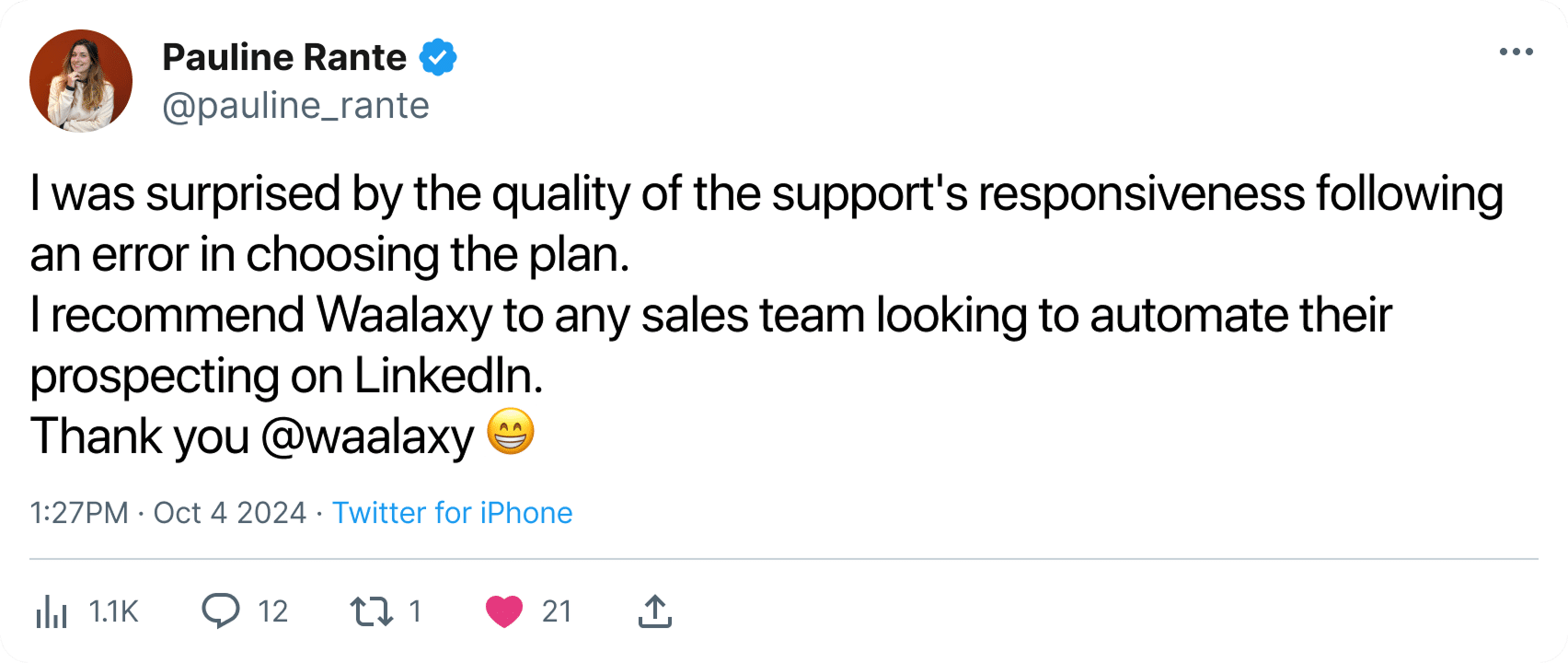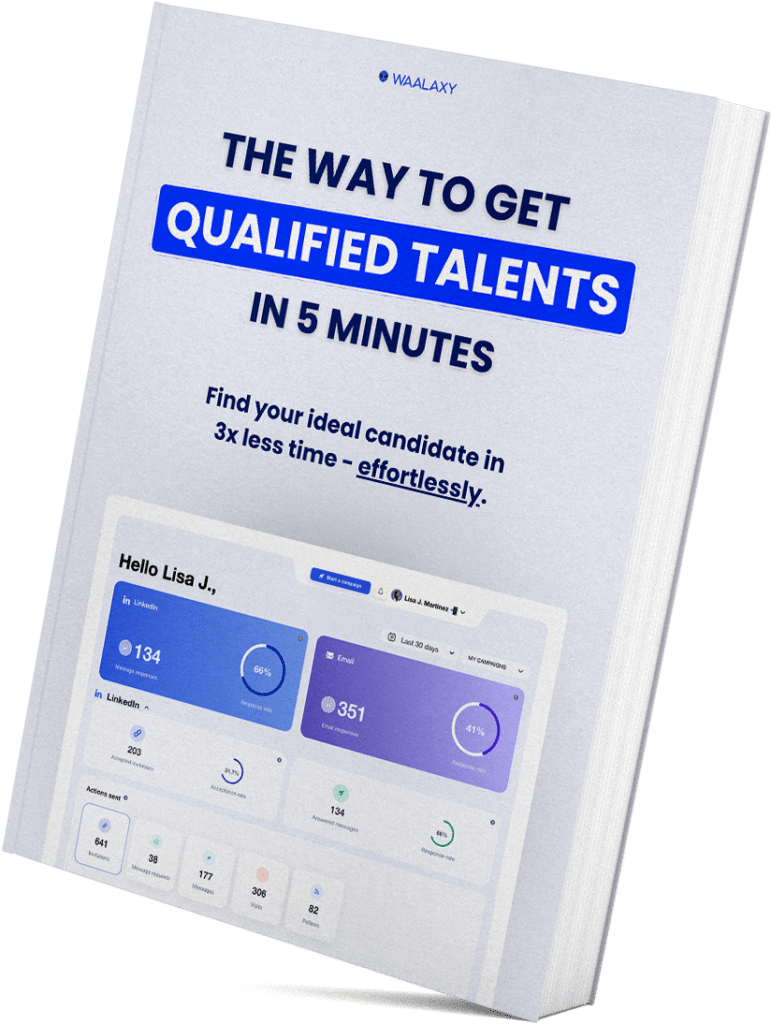Today, selling is no longer enough: you have to sell better, faster, and more efficiently ⚡.
Sales Enablement provides sales teams with the right tools, content, and processes to perform on a daily basis 🚀.
Whether you’re in Sales Ops, SDR, or Sales Management, you’re probably looking for 👇🏻:
- Improve your sales performance.
- Align marketing and sales.
- Track the real impact of your actions.
In this article, we explain what it is, its key pillars, its limitations, and, above all, the 8 best Sales Enablement tools to adopt. 👀
What is Sales Enablement?
Sales Enablement is about giving sales teams everything they need to sell better 💼. In concrete terms, it involves structuring sales performance through three essential levers 👇🏻:
- Relevant content.
- Appropriate tools.
- Ongoing training for your sales teams.
Sales Enablement Definition
Sales Enablement is defined as the set of processes, tools, and resources that enable salespeople to interact more effectively with prospects and close more deals. 💰
We align marketing strategy, sales training, and technology to boost performance. 😎
Why has sales enablement become essential?
B2B sales cycles have lengthened, there are more people involved in the decision-making process, and buyers are doing their own research before even talking to a sales rep. 👩🏻💻
As a result, without a clear enablement strategy, your teams risk wasting time, misusing content, and missing opportunities. 😅
The limits of sales enablement
On paper, sales enablement seems magical ✨. But in reality, many companies fail to realize its full potential… and this is often due to these classic mistakes:👇
- Tools that don’t talk to each other: CRM, content, training, reporting …each one in its own corner. Without integration, it’s impossible to get a clear picture of what’s working and what’s not 🔍.
- Too much theory, not enough practice: Processes, materials, and guidelines are created… but without any direct link to the real needs of salespeople. As a result, they don’t use the tools and continue to do “their own way” 😅.
- Tools that are too complicated: If a platform takes three days to understand, it will never be adopted. Sales enablement should simplify everyday life, not make it more complex 🧩.
And then there’s the big question: Is CRM enough for sales enablement?
Well… no. CRM manages customer data, but it doesn’t train your teams, align your messages, or equip your sales force. It records, but it doesn’t activate.
The pillars of a sales enablement strategy
Implementing a sales tools strategy is not simply a matter of adding another tool to your sales stack. 👀
It’s above all a comprehensive approach that aims to align strategy, sales teams, and technology around a single goal: making your salespeople more effective, consistent, and autonomous. 😎
1. Sales enablement tools and contents
A successful salesperson is, above all, someone who has quick access to the right content at the right time and knows how to use it intelligently during the sales cycle. 🔄
And yet… according to several studies, more than 65% of the content produced by marketing teams is never used by salespeople. This is because they don’t know where to find it, or because it is not suited to their needs in the field. 🥲
Sales Enablement solves this major problem by centralizing and making all content useful for sales actionable 👇🏻:
- 🎯 Customizable pitch decks and sales presentations;
- 📄 Relevant case studies and customer testimonials;
- 🧾 Tested and optimized sales calls scripts and email sequences;
- 💡 Product guides, sales pitches, and objection sheets;
- 📈 Easily shareable marketing content (white papers, videos, LinkedIn posts, etc.).
”With well-configured sales support software, every sales rep knows exactly what content to use depending on the stage of the buying process. Content is no longer stock “, but a performance lever. ✨
2. Marketing & sales alignment
We all know that between marketing producing content that no one uses and salespeople saying, ” “, we don’t have anything up to date”,” communication is often… complicated.😅
Sales Enablement is here to reorganize all that. Its goal is to get marketing and sales working hand in hand, so that everyone speaks the same language and pursues the same objectives.
By centralizing content, sharing usage data, and encouraging feedback from the field, we create a true collaboration loop. Marketing finally understands what salespeople need, and sales has truly effective tools to convince their prospects 🎯.
3. Training and ongoing coaching
Training your salespeople once a year is no longer enough.
Sales enablement is based on a logic of continuous skill development, because markets evolve, tools change, and prospecting methods change too.
The idea is simple: give teams best practices at the right time to help them adopt messages, processes, and tools more quickly. We’re talking about 👇🏻:
- 🎓 Structured onboarding for new arrivals.
- 🧩 Regular micro-learning (quick, targeted, actionable).
- 🤝 Individual coaching and role-play sessions.
- 📊 Feedback based on field data.
A well-trained salesperson is one who adopts the tools, makes use of the content, and therefore gains autonomy more quickly. 🧚🏻♀️
4. Technology and automation
It is impossible to imagine an effective sales enablement strategy without a minimum of automation. Technology is there to simplify the lives of sales teams, not to complicate them.
The right sales enablement software help centralize data, analyze performance, and, above all, act faster: lead tracking, automatic follow-ups, intelligent lead scoring, one-click content sharing… everything becomes more fluid.✨
Automation frees up sales reps’ time so they can focus on what really matters: customer relationships and conversions. No more repetitive tasks—it’s time for targeted, personalized, and measurable actions.
Technology does not replace strategy. It must accompany it, making processes more efficient. 😎
Comparison of the 8 best Sales Enablement tools
The market is full of sales enablement tools: content platforms, training software, automation solutions… It’s not always easy to find your way around 😅.
To make your life easier, here is a comparison of the 8 best Sales Enablement tools.😇
1. Sales Enablement Software : Seismic
Seismic is one of the heavyweight B2B Sales Enablement tools, built for big organizations that need structure, scalability, and deep analytics. It helps marketing and sales enablement teams work together seamlessly by giving sellers the right content at the right time.🕰️
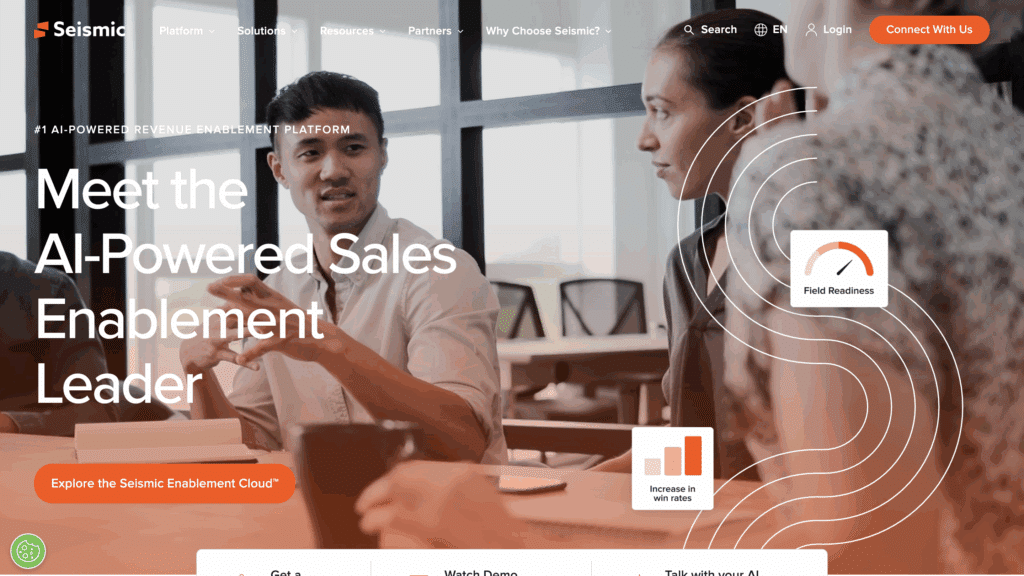
Key Features
- 📑 Powerful sales content management system with personalization options.
- 📊 AI-powered analytics and engagement tracking.
- 👩🏻💻 Built-in sales coaching modules.
- 🔗 Tight CRM and marketing integrations (Salesforce, HubSpot…)
| Pros | Cons |
| ✅ Robust for enterprise teams. ✅ Great reporting and analytics dashboards. ✅ Trusted by many Fortune 500 companies. | ⚠️ Long onboarding process. ⚠️ Complex pricing, mostly designed for large enterprises. |
Pricing of Seismic
💰 Custom pricing, expect an enterprise-level investment.

2. Sales Enablement tools : Highspot
Highspot is one of the most advanced Sales Enablement tool out there. It focuses on improving how sales reps use content, training, and analytics to engage buyers more effectively. ✨
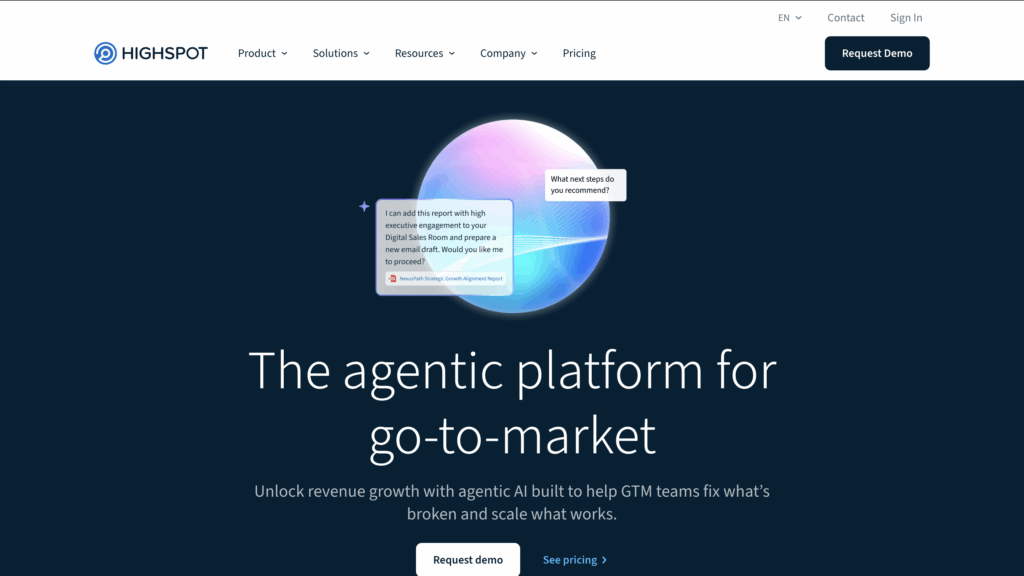
Key Features of Highspot
- 📸 Centralized content management and sharing.
- 🤖 AI-powered recommendations for better deal engagement.
- 😎 Built-in sales training and coaching.
- 📈 Deep analytics on buyer interactions.
| Pros | Cons |
| ✅ Great balance between enablement and analytics. ✅ Works seamlessly with major CRMs tools. | ⚠️ High pricing tier for small businesses. ⚠️ Feature-rich but can be overwhelming for smaller teams. |
What is the price of Highspot ?
Custom pricing, typically for mid-size to enterprise accounts. 👀

3. Sales Enablement tools : Showpad
Showpad blends Sales Enablement and training in one clean, user-friendly platform.
It’s perfect for companies that want to unify marketing assets, sales enablement content strategy and onboarding tools under a single roof 🏠.
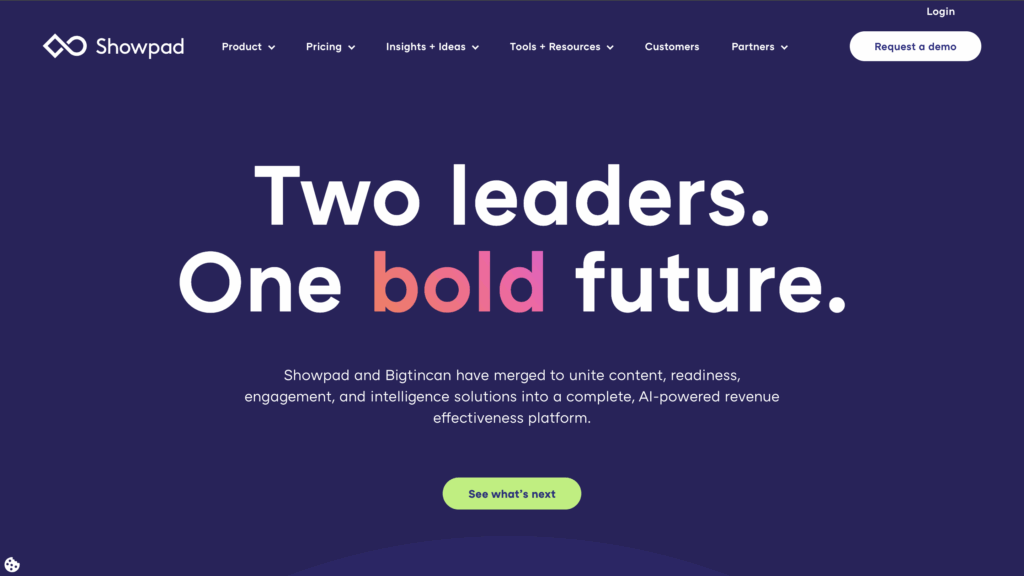
The main features of Showpad
There are 👇🏻 :
- Centralized content hub for all sales materials.
- Interactive training modules for reps.
- Smart content analytics and recommendations.
| Pros | Cons |
| ✅ Intuitive interface and mobile-friendly design. ✅ Great adoption among hybrid or remote sales teams. | ⚠️ Cost per user can scale fast. ⚠️ Some features overlap with other tools, which can confuse smaller teams. |
How much cost Showpad ?
We don’t know. You have to request a demo. 😒
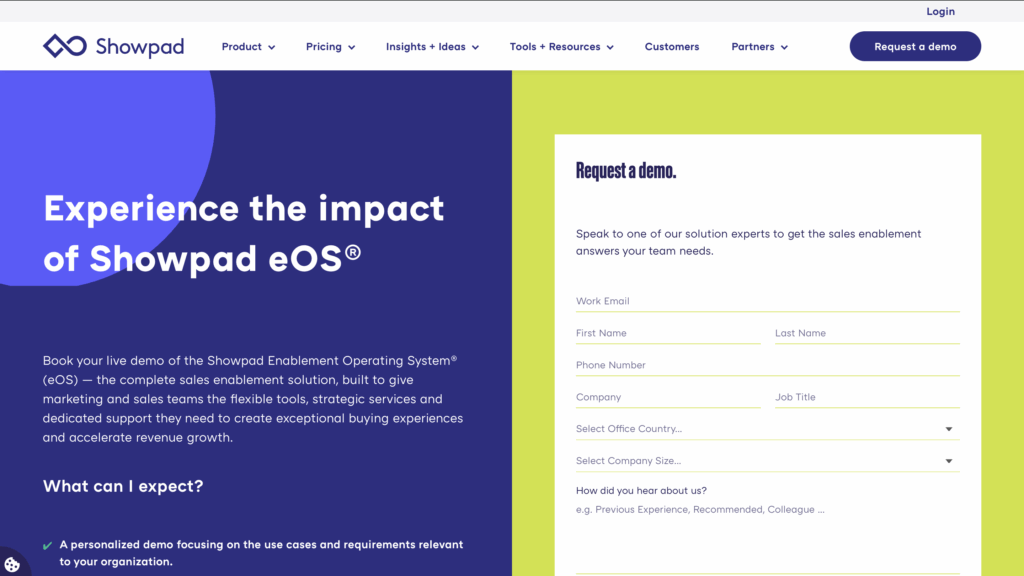
4. Sales Enablement software : Gong
Gong isn’t your traditional Sales Enablement tool, it’s an AI conversation intelligence platform that helps B2B sales teams analyze sales calls, demos, and deals to sell smarter. 😌

Key Features of Gong
The main features are :
- ☎️ AI call recording and analysis.
- 👩🏻🏫 Real-time feedback for reps and managers.
- 📊 Deal intelligence dashboards.
| Pros | Cons |
| ✅ Great for coaching and improving messaging consistency. ✅ Data-driven insights. ✅ Ideal for high-volume SDR or AE teams. | ⚠️ Expensive for smaller companies. ⚠️ Works best when you already have a solid sales process. |
Pricing Gong
Like the others tools, you have to contact sales team to know the price. 🙃
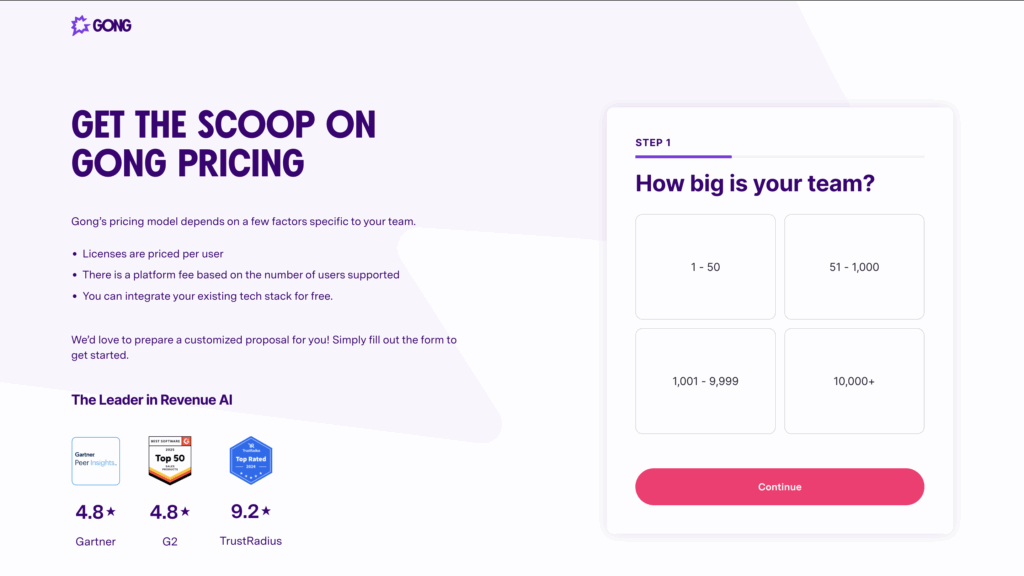
5. Sales Enablement platform : Spekit
Spekit focuses on micro-learning and tool adoption, making it a perfect fit for fast-moving B2B sales teams that are constantly adapting to new tools or processes 📚.
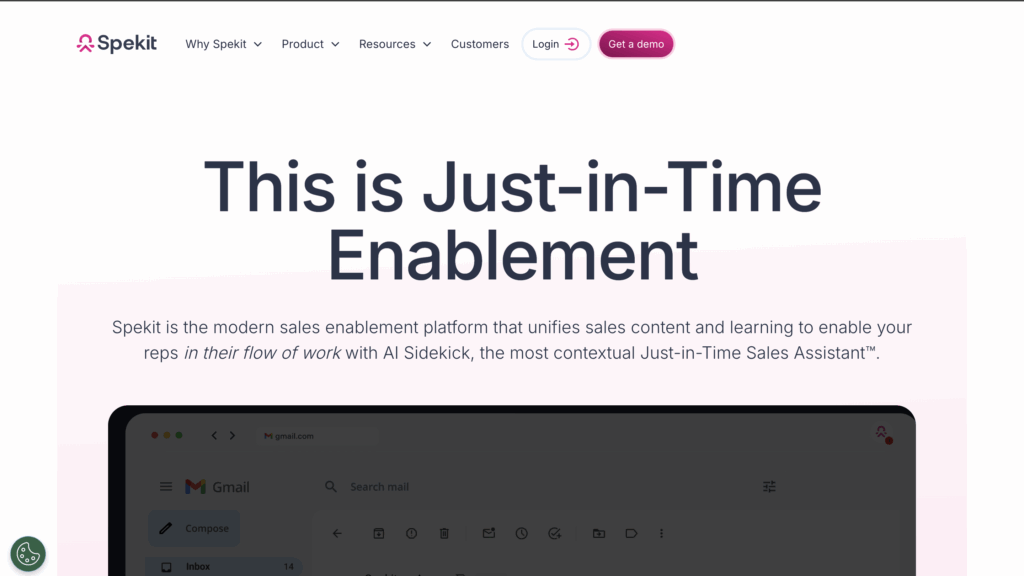
The features of Spekit
This tool help you for 👇🏻:
- Real-time in-app learning pop-ups.
- Onboarding and enablement templates.
- Centralized knowledge base.
- Integration with Salesforce, Slack and Chrome.
| Pros | Cons |
| ✅ Super easy to set up and use. ✅ Keeps reps productive without leaving their workflow. | ⚠️ Limited analytics. ⚠️ Not a full prospecting or automation platform. |
What is the price of Spekit ?
There is no price, you have to chat with an enablement expert. 😅
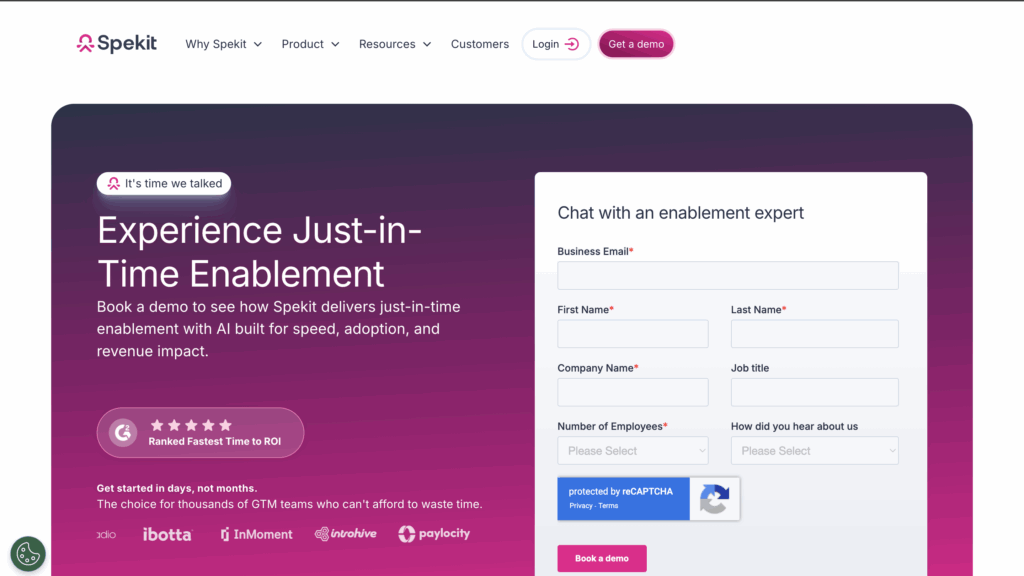
6. Sales Enablement tools : WorkRamp
WorkRamp is an all-in-one learning management system (LMS) with strong Sales Enablement features. It helps sales teams train faster, onboard better and keep skills fresh ideal for companies with complex sales cycles 🧠.
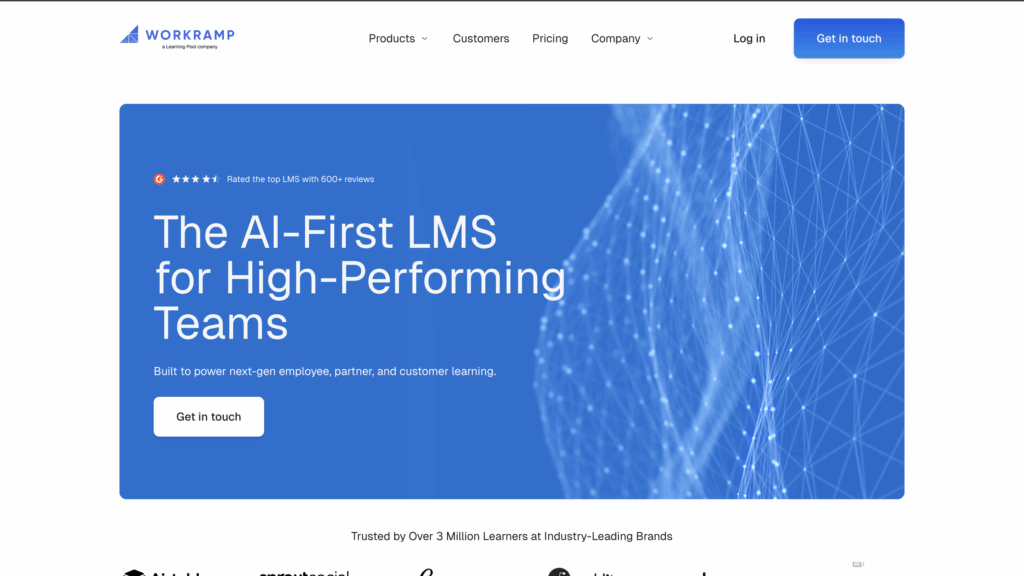
Key feature of Workramp
You can use it for :
- 🎨 Customizable training programs and certifications.
- 🛠️ Coaching tools for managers.
- 📈 Analytics on learning impact.
- 📲 Integrations with Slack, Zoom and Salesforce.
| Pros | Cons |
| ✅ Excellent for scaling training and onboarding. ✅ Clear reporting on enablement progress. ✅ Clean and modern interface. | ⚠️ Less focused on daily sales execution. ⚠️ Can feel like a pure LMS rather than a full Sales Enablement suite. |
The price of Workramp
It’s a custom pricing, it’s depend of your size compagny. 👭
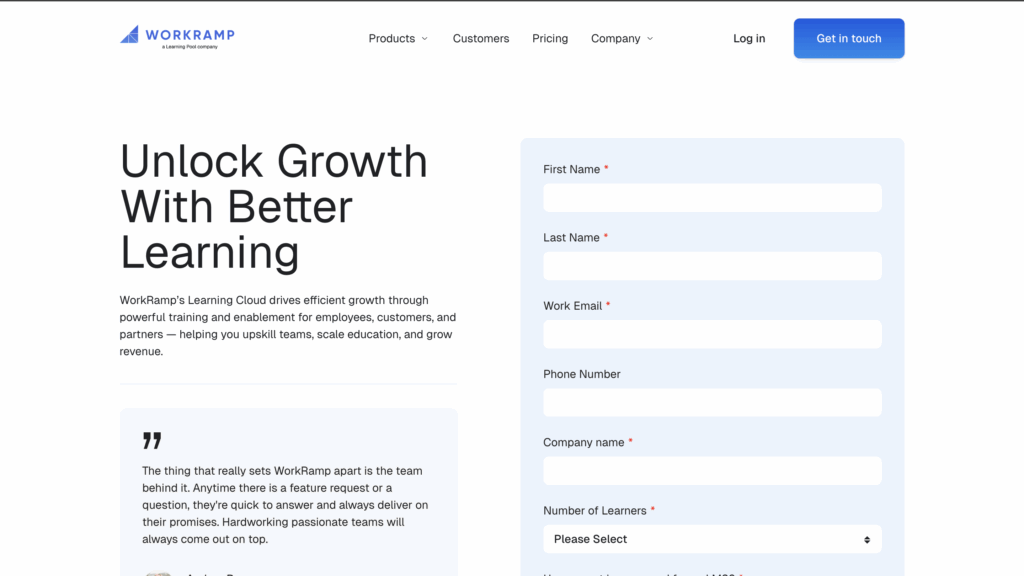
7. Sales Enablement platforms : SalesLoft
SalesLoft bridges the gap between Sales Engagement and Enablement, helping B2B teams automate outreach while staying personal 💬. If your reps live in LinkedIn and email, this one’s can be a favorite. ✨
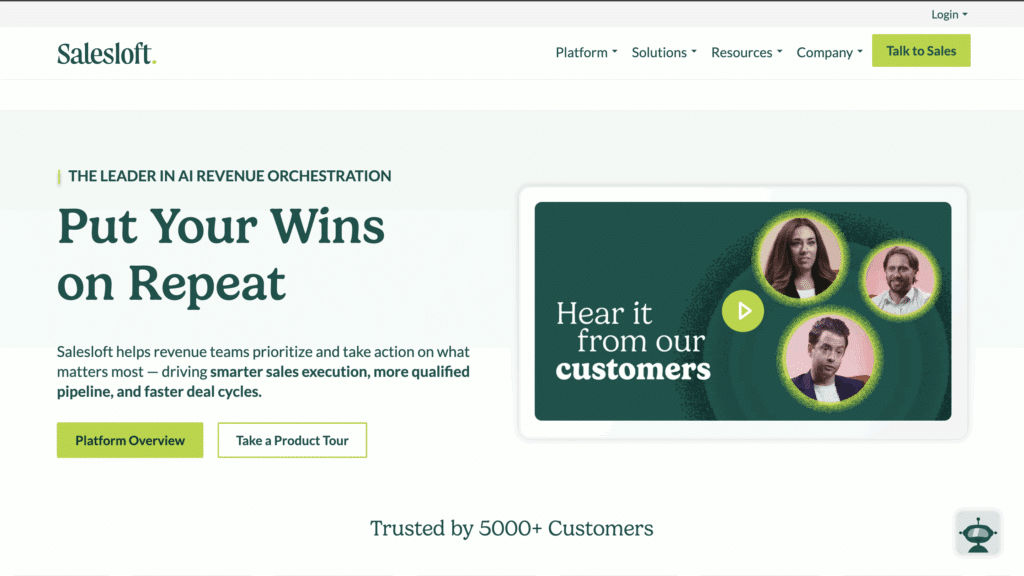
The main Salesloft features
- 🔗 Multichannel sequencing (cold-email, LinkedIn, calls).
- 📚 Playbooks and templates for consistent outreach.
- 📊 Analytics dashboards for pipeline and performance.
| Pros | Cons |
| ✅ Great for outbound teams. ✅ Strong analytics and coaching tools. ✅ Good user experience. | ⚠️ Mostly focused on prospecting, less on training. ⚠️ High cost for small teams. |
Salesloft pricing, What it’s ?
There is no price cleary, it’s a custom price. 🙁
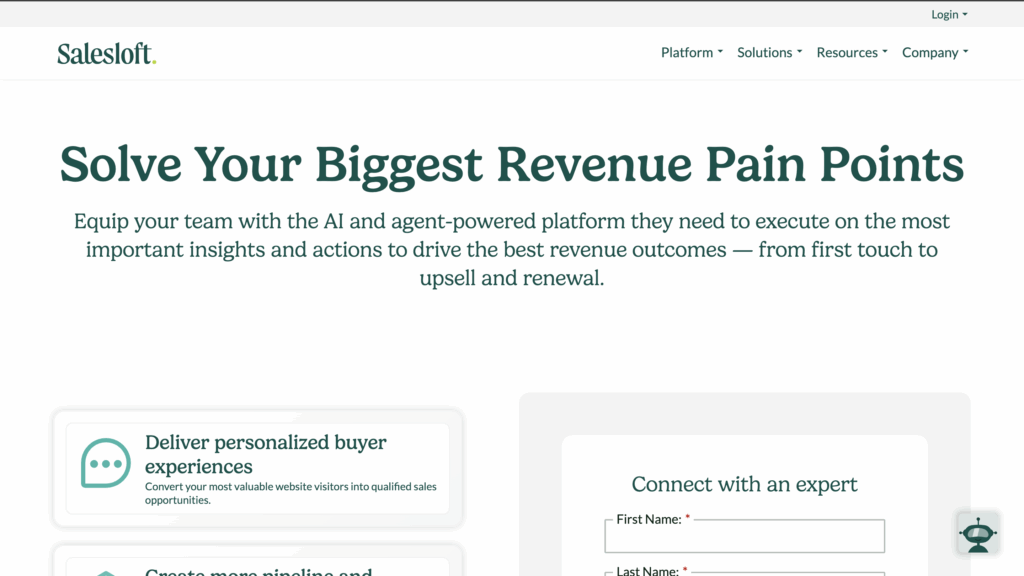
8. Sales Enablement software : Waalaxy
The tools above feel a bit heavy or pricey, Waalaxy might just be your secret weapon 😉.
It’s a lightweight B2B Sales Enablement tool built for teams that want to act fast, automate smart, and grow efficiently.
Unlike many “enterprise-only” platforms, Waalaxy helps sales teams connect strategy to action; from prospecting to engagement, all in one intuitive interface. 😎
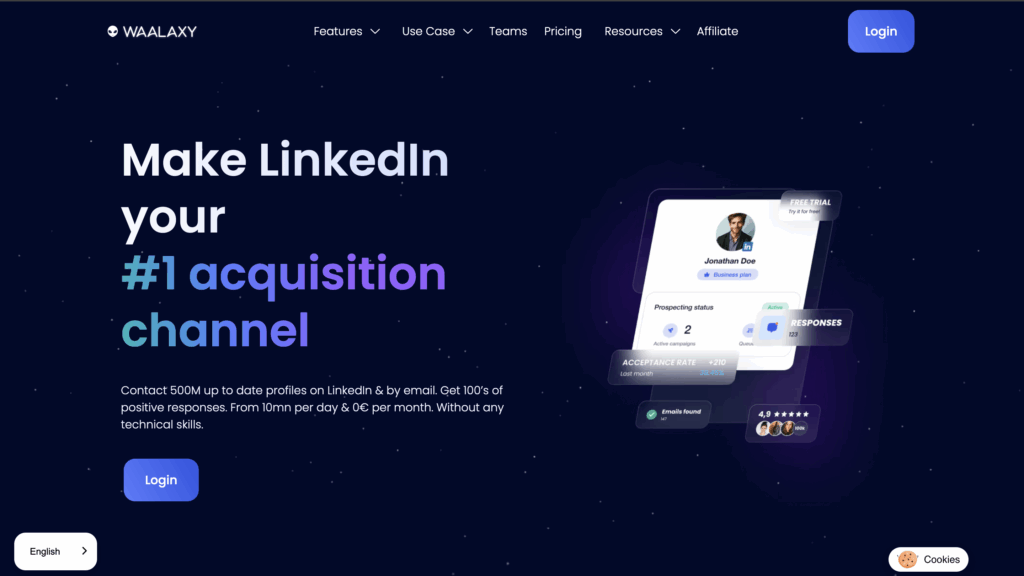
The key features of Waalaxy
With Waalaxy, you can do :
- ✨ Multichannel automation (LinkedIn + Email).
- 🔗 Smart sequences to nurture leads automatically.
- 🤖 AI features (Email Finder, reponse analyse)
- 👩🏻💻 Prospect enrichment and segmentation.
- 📚 Training and resources via Waalaxy’s blog, webinars, and white-books.
| Pros | Cons |
| ✅ Simple, intuitive and ready to use in minutes. ✅ Ideal for small to mid-sized B2B sales teams. ✅ Affordable and fully scalable. ✅ Educational ecosystem to inform your team fast. ✅ 4,8/5 on Google Chrome extension. | ⚠️ Less focused on deep analytics and LMS-style training (by design). |
Waalaxy pricing
Monthly
Quarterly
Yearly
Without Inbox
With Inbox
Add-on
This a recap of the 8 best Sales enablement tools 👇🏻 :
| Tool | Estimated price/model | Key features | Advantages | Limitations |
|---|---|---|---|---|
| Seismic | On demand | Content management, coaching, analytics, automation | Very comprehensive solution, strong recognition | Expensive, long implementation time |
| Highspot | On demand | Content management, AI guidance, analytics | Excellent analytics tracking, | Very expensive, more suited to large accounts |
| Showpad | On demand | Centralization of content, training, and analytics | Modern UX, good field use | High user cost, very broad functionality |
| Gong | On demand | Conversational intelligence, call coaching | Ideal for improving sales pitches | Requires high call volume, high cost per user |
| Spekit | On demand | Micro-learning, tool adoption, content management | Very good for just-in-time training “” | Less focused on multichannel prospecting |
| WorkRamp | On demand | LMS and onboarding with continuous training | Suitable for training/onboarding teams | Less focused on field execution “” , and prospecting |
| SalesLoft | On demand | Prospecting automation, email sequences, and LinkedIn | Very effective for field activities | Less “total sales enablement platform” than others |
| Waalaxy | Freemium at $0/month, then plans starting at $19/user/month (Pro), $49/user/month (Advanced), $69/user/month (Business) | Multi-channel prospecting (LinkedIn + email), email finder & enrich, sequence automation, training blog/webinars. | Very accessible, multi-channel, good for small & medium-sized teams | Premium features require payment, less focused on training. |
How to choose and deploy a Sales Enablement solution?
Finding the right sales enablement tool is great ✅. But the most important thing is to implement it effectively so that your teams adopt it and it generates real sales results 💪 .
A sales enablementproject is not just about installing software or sharing a few marketing materials. It is a comprehensive approach that aims to structure sales performance around well-aligned tools, content, and processes. 😎
1. Define your project before you start
Before rushing into a solution, take the time to establish a clear framework.
A successful rollout always starts with a simple question: “What specific problem are we trying to solve?”
Do you want to:
- Improve the training and skills development of your sales representatives?
- Centralize and track the use of marketing content?
- Automate multi-channel prospecting to increase efficiency?
👉 Defining your priorities means avoiding choosing a catch-all tool “” that doesn’t meet any specific needs.
Next, it’s essential to involve your teams from the outset. Salespeople, managers, and marketers shouldn’t discover the tool once it’s been installed; they need to be involved in its design and selection. They’re the ones who will be using it on a daily basis, so you might as well make sure it fits their reality in the field.
Organize a one-hour workshop with your teams to gather their expectations, frustrations, and ideas for improvement. This will give you concrete insights and help you build a project that makes sense for everyone. 🌎
2. Build a strong project team
A successful solution deployment is never a solo effort. Before rolling out your sales enablement tool across the board, create a small pilot group to test it and bring it to life on a daily basis.
The idea is to bring together complementary profiles: a sales manager who understands the field, a marketing person to ensure content consistency, a sales ops person for the technical side, and a few motivated salespeople to test it in real-world conditions.😎
This team should be your internal driving force. They experiment, report difficulties, share successes, and prepare the ground for larger-scale deployment.
Above all, it serves as a trusted intermediary: when colleagues see that their peers are using the tool and finding value in it, adoption becomes natural.
3. Roll out your strategy gradually
Many companies fail in their Sales Enablement projects simply because they want to launch everything at once 😅. The result: information overload, misunderstanding on the part of the sales teams, and virtually zero adoption.
The key is smart progression 💡. Start small, test, learn, then expand. Your goal is not to go fast, but to build a solid foundation that will be adopted for the long term.
Start with a pilot phase with a small, motivated, and representative team. This step will allow you to 👇🏻:
- Identify barriers to adoption (time, understanding, technical integration).
- Validate the relevance of the tool in the daily lives of sales representatives.
- Gather concrete feedback from the field to make adjustments before global deployment.
Once these initial lessons have been learned, gradually roll out the solution: team by team, or segment by segment. Each deployment will then become smoother, more controlled, and better understood. 🫡
➡️ Above all, highlight quick win “” , which will be visible from the very first weeks:
- Time saved on content research.
- A higher response rate.
- Better coordination between marketing and sales.
4. Train and support your teams
Let’s be honest, even the best tool in the world is useless if your teams don’t know how to use it.😒
Once the solution has been deployed, put a simple and practical training plan in place. There’s no need for endless or overly theoretical sessions. Opt for short, interactive formats that are useful on a daily basis: a live demo, a webinar , or a short introductory video. 👩🏻🏫
The idea is for your sales reps to quickly see how the tool changes things for them. Also encourage sharing among colleagues. Those who master the solution will become your best ambassadors.
Above all, don’t let training stop after launch. Continue to support your teams over time: remain available, respond quickly to questions, and celebrate progress. It’s these small daily follow-ups that create real momentum for adoption 🤝.
In short, a good tool saves time, but good training improves performance. Both together? That’s the recipe for a successful Sales Enablement project. 🥳
5. Measure, adjust, and continuously improve
Deploying a sales enablement tool is not a final step, it is a continuous cycle of improvement 🔁. Once the solution has been adopted, the challenge is to measure its impact and regularly adjust the strategy to maintain momentum.
Start by tracking a few simple but essential sales enablement kpis 👇🏻:
- 👭 The adoption rate of the tool by teams.
- 📆 The frequency of use of content or sequences.
- 📑 The sales pipeline generated through prospecting.
- 💰 Conversion rates before/after implementation.
This data, your key sales enablement metrics, will help you identify what works and what needs to be optimized. But numbers alone are not enough: also take into account qualitative feedback from the field.
Salespeople know better than anyone what makes their daily work easier or, conversely, what slows them down. Their feedback will enable you to adjust processes, improve content, and refine the use of the tool. 😉
Next, highlight the results. Share the progress made, highlight successes, and congratulate the teams involved. Showing quick wins “” , time savings, better marketing/sales collaboration, and higher closing rates motivates everyone and reinforces the legitimacy of the project.
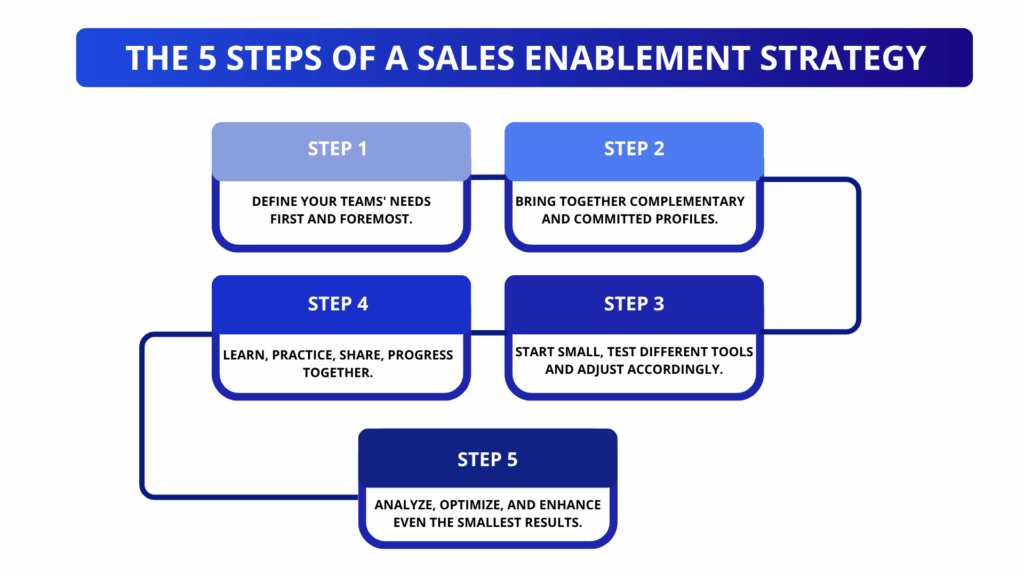
Sales enablement examples
Because a good example is worth a thousand words 😉. Let’s take the case of a team of 10 SDRs in a B2B scale-up that was looking to increase efficiency. Their prospecting was based on time-consuming manual tasks: copying and pasting messages, manually following up with prospects, and juggling multiple tools without any real follow-up. The result? A waste of time, little visibility on the pipeline, and a frustrated team.
They then decided to integrate Waalaxy into their Sales Enablement strategies . The goal was to automate multi-channel prospecting while maintaining a personalized approach.
In just a few days, they were able to 👇🏻:
- Create automated LinkedIn + email sequences tailored to their personas.
- Centralize their leads in a single tool.
- Track performance in real time.
- Train the team via the Waalaxy blog and webinars to quickly adopt best practices.

Results after 2 months 📈:
- 60% s from automated prospecting.
- A 30% increase in the pipeline .
- SDRs focused on what they do best: engaging the right prospects at the right time.
By combining automation, content, and training, Waalaxy has become the operational tool for Sales Enablement, connecting strategy to action without unnecessary complexity.
Shall we recap on sales enablement tools?
Selling today is no longer just about signing deals: it’s about selling better, faster, and smarter ⚡.
Sales Enablement tools is what connects strategy to action. It aligns marketing and sales, structures content, and helps your teams perform on a daily basis. With the right tools, the right processes, and real support, you can transform your sales force into a value-creating machine.
So, more than just a concept, sales enablement tools are a concrete lever for performance and consistency. And when implemented well, they can really change the game 💪✨.
Frequently asked questions
What is the role of a Sales Enablement Manager?
The Sales Enablement Manager is the conductor of sales performance.
Their role? To implement the tools, training, and content that enable salespeople to be more effective on a daily basis.
In concrete terms, they create links between the sales and marketing teams, identify needs in the field, measure performance indicators, and continuously optimize sales processes. They are the link between strategy and execution: they don’t sell “” , but they make others better at selling 💪.
A good Enablement Manager embodies effective sales enablement management — facilitating team alignment, helping reps adopt the right habits, use their tools efficiently, and capitalize on what truly drives results.
Sales enablement vs Sales operations
They’re closely connected, but their focus and impact aren’t the same. Here’s a clear breakdown :👇
| Aspect | Sales Enablement | Sales Operations |
|---|---|---|
| 🎯 Main goal | Improve individual sales performance through training, content and tools. | Optimize processes and overall sales efficiency across the organization. |
| 🧠 Focus | Coaching, tool adoption, marketing-sales alignment, quality of buyer interactions. | Reporting, forecasting, CRM management, quotas, compensation and structure. |
| ⚙️ Core role | Help reps sell better through enablement, data. | Help the company sell smarter through process design and efficiency. |
| 📊 Key metrics | Sales enablement metrics like tool adoption, content usage, conversion rate. | Pipeline growth, forecast accuracy, productivity per rep. |
| 🤝 Collaboration | Works with marketing and sales management. | Works closely with sales leadership and operations teams. |
| 🚀 End impact | Makes reps more autonomous, skilled and effective. | Makes the sales engine more predictable, measurable and scalable. |
Now you know everything there is to know about sales enablement tools. 🧚🏻♀️


